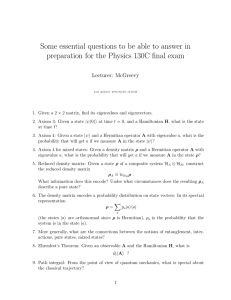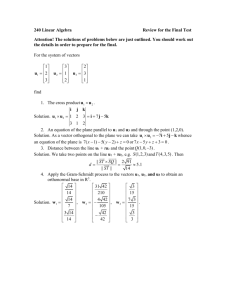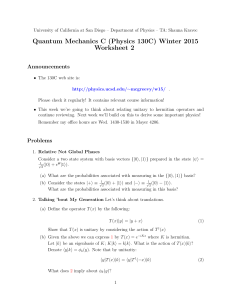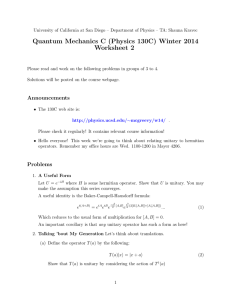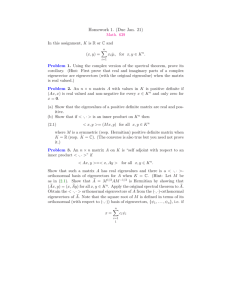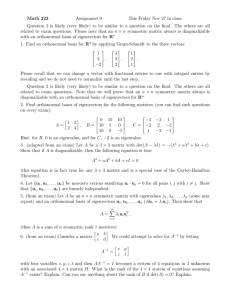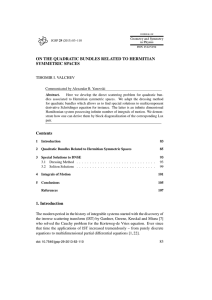Math 223 Symmetric and Hermitian Matrices. = Q
advertisement
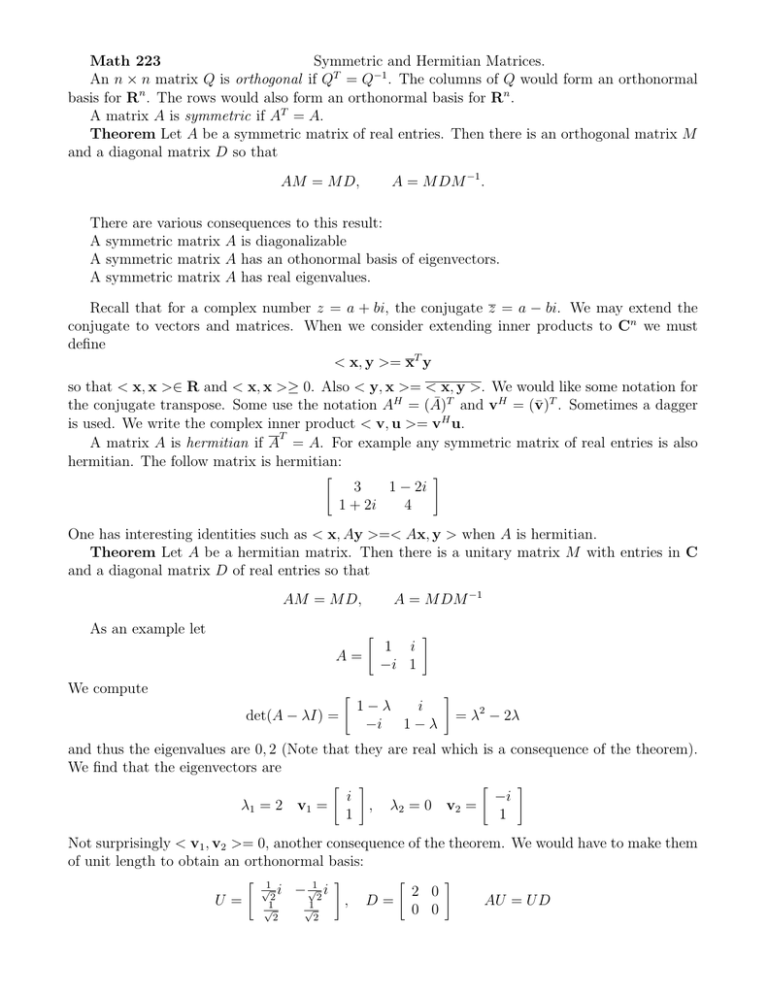
Math 223 Symmetric and Hermitian Matrices. An n × n matrix Q is orthogonal if QT = Q−1 . The columns of Q would form an orthonormal basis for Rn . The rows would also form an orthonormal basis for Rn . A matrix A is symmetric if AT = A. Theorem Let A be a symmetric matrix of real entries. Then there is an orthogonal matrix M and a diagonal matrix D so that A = M DM −1 . AM = M D, There are various consequences to this result: A symmetric matrix A is diagonalizable A symmetric matrix A has an othonormal basis of eigenvectors. A symmetric matrix A has real eigenvalues. Recall that for a complex number z = a + bi, the conjugate z = a − bi. We may extend the conjugate to vectors and matrices. When we consider extending inner products to Cn we must define < x, y >= xT y so that < x, x >∈ R and < x, x >≥ 0. Also < y, x >= < x, y >. We would like some notation for the conjugate transpose. Some use the notation AH = (Ā)T and vH = (v̄)T . Sometimes a dagger is used. We write the complex inner product < v, u >= vH u. T A matrix A is hermitian if A = A. For example any symmetric matrix of real entries is also hermitian. The follow matrix is hermitian: " 3 1 − 2i 1 + 2i 4 # One has interesting identities such as < x, Ay >=< Ax, y > when A is hermitian. Theorem Let A be a hermitian matrix. Then there is a unitary matrix M with entries in C and a diagonal matrix D of real entries so that A = M DM −1 AM = M D, As an example let " A= 1 i −i 1 # We compute " det(A − λI) = 1−λ i −i 1 − λ # = λ2 − 2λ and thus the eigenvalues are 0, 2 (Note that they are real which is a consequence of the theorem). We find that the eigenvectors are " λ1 = 2 v 1 = i 1 # " , λ2 = 0 v2 = −i 1 # Not surprisingly < v1 , v2 >= 0, another consequence of the theorem. We would have to make them of unit length to obtain an orthonormal basis: " 1 √ U= i − √12 i 2 √1 2 √1 2 # " , D= 2 0 0 0 # AU = U D Let A be an n × n matrix. The proof of either of our theorems first requires us to find a real eigenvalue. Assume A is hermitian so that AH = A. Now det(A − λI) is a polynomial in λ of degree n. By the Fundamental theorem of Algebra it factors into linear factors. Let µ be a root which might not be real but will be complex. Let v be an eigenvector of eigenvalue µ (computed using our standard Gaussian Elimination over C). Then Av = µv. We compute vH AH = µvH . By symmetry of A, vT AT = vT A. Thus vT Av = µvH v but also T An n × n matrix U is unitary if U = U −1 . The columns of U would form an orthonormal basis for Cn . The rows would also form an orthonormal basis for Cn . The following matrix is unitary: " " # " # " #T " # " i 1+i # 1 1 i −i 1 1 1 1 since = and = 0. i −i −i −i Using this inner product one can perform Gram Schmidt on complex vectors (but be careful with the order since in general < u, v >6=< v, u.): " v1 = 2 1+i u1 = v1 , # , v2 = # " , < u1 , v2 > u1 = u2 = v2 − < u1 , u1 > < v1 , v2 >= [2 1 − i] " i 1+i # 2 + 2i − 6 " i 1+i 2 1+i # # = 2i + 2. " = − 32 + 13 i 1 + 31 i You may check " < u1 , u2 >= [2 1 + i] − 32 + 13 i 1 + 13 i # 4 2 4 2 =− + i+ − i=0 3 3 3 3 To form a unitary matrix we must normalize the vectors. " 2 1+i # " → √1 6 √2 6 + # √1 i 6 " , " U= T √1 6 − 23 + 13 i 1 + 13 i √2 6 # " → −2 + i 3+i − √215 + √115 i + √16 i √315 + √115 i # " → − √215 + √115 i √3 + √1 i 15 15 # where we can check U U = I. Best to let a computer do these calculations! # #
